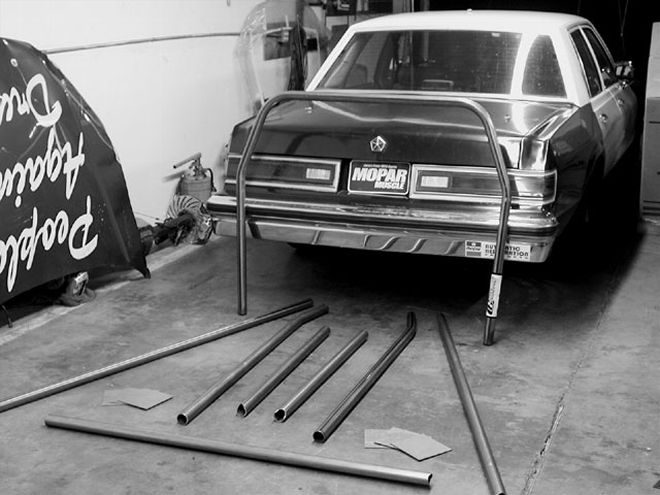
 We didn't install a rollbar in our Diplomat to conform to the rules of our class in the Nevada Open Road Challenge, since we didn't need one to comply. Instead, we installed a rollbar to protect the safety of the two yahoos traveling at triple-digit speeds. In order to make our bar compliant, a couple of items would need to be addressed (the diagonal brace would have to be added, as well as an inspection hole). If we run the car in the future in a faster class, we will have to make the changes required in the SSCC rules for conformity.
We didn't install a rollbar in our Diplomat to conform to the rules of our class in the Nevada Open Road Challenge, since we didn't need one to comply. Instead, we installed a rollbar to protect the safety of the two yahoos traveling at triple-digit speeds. In order to make our bar compliant, a couple of items would need to be addressed (the diagonal brace would have to be added, as well as an inspection hole). If we run the car in the future in a faster class, we will have to make the changes required in the SSCC rules for conformity.
Finishing any racing event shiny side up should always be the main goal. On rare occasions, things can get dicey and next thing you know, you're upside down. When we entered into this project, we decided no matter what speed class we would participate in during the Nevada Open Road Challenge, we would outfit the Stealth Bomber with a rollbar. It just made good sense, added negligible weight, and provided us with a modicum of security should things go bad at triple-digit speeds.
Since an M-body can safely be referred to as a less-than-mainstream project vehicle, we had to do some measuring to see what application's rollbar would best fit this body style. We decided that we would source Competition Engineering (C.E.) for one of their rollbar kits. Because our project '68 Barracuda is sporting a C.E. rollcage, a quick measuring indicated the width would be perfect for our Diplomat. So we contacted Competition Engineering and carted our rollbar kit over to Sleeper Suspension Development for a custom installation.
Rollbar Rules
The rollbar rules differ slightly between NHRA (National Hot Rod Association) and SSCC (Silver State Classic Challenge) sanctioning bodies, but with the same objective-to keep occupants alive in the unfortunate event of a rollover. The NHRA requires a rollbar in any vehicle running 11.99 or better (13.99 in the case of a convertible), while the SSCC mandates a bar in the Grand Sport division (130- to 150-mph classes with a maximum "tech speed" of 165 mph), and recommends a rollbar in the Grand Touring (115- to 125-mph classes with a maximum "tech speed" of 140 mph) and Touring (95- to 110-mph classes with a maximum "tech speed" of 124 mph) divisions. But the rules differ basically on a couple of fronts. According to the SSCC's rules, a diagonal brace must be added to triangulate the main hoop. The SSCC also recommends that the brace be attached at the top of the driver side of the hoop and to the bottom of the passenger side. Also, the NHRA requires a sidebar on the driver side of the vehicle that must pass the driver at a point between the shoulder and the elbow, whereas the SSCC does not require such a door bar for a rollbar. The SSCC requires an inspection "window" (a hole at least 3/16-inch diameter) be drilled in an area that will not compromise strength (at least 3 inches from any weld or bend) to allow for verification of wall thickness. Rollbar tubing thickness is also regulated by the SSCC based on the weight of the car (any vehicle over 2,700 pounds has to have an 1 3/4-inch bar), whereas the NHRA mandates 1 3/4-inch tubing (mild steel or chromoly) at .118-inch thick (chromoly can be .083-inch thick). There are some other minor differences, but we feel they are negligible. To acquire an NHRA rule book online, log onto www.nhra.com or call (626) 914-4761. The SSCC rules are posted on their web site at www.sscc.us.